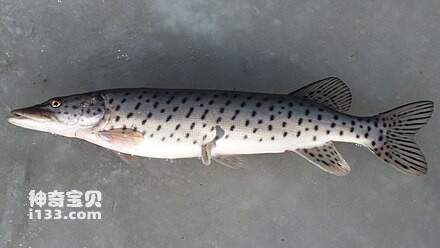Pike (Esox reicherti) belongs to the order Salmoniformes, family Pike, and genus Pike. It is commonly known as: duck fish, black-spotted pike. Pike grows fast and has a long lifespan. Some people have found individuals weighing 30-35 kilograms and being 70 years old. It is said that the longest lifespan can be more than 200 years old.
The body of the pike is slender, slightly flattened laterally, and the tail peduncle is short. The head is pointed and the snout is particularly long and flat, like a duck's bill. The cleft of the mouth is extremely wide, and the corners of the mouth extend backward up to half the length of the head. The teeth are well developed, with tapered sharp teeth of different sizes on the upper and lower jaws, vomer, ethmoid and tongue. Its teeth are unique. The upper teeth can stick out and are connected by ligaments. These sharp teeth can catch captured animals and sometimes hang uneaten food on the teeth for later use. The scales are small and the lateral lines are not obvious. The dorsal fin is located later, close to the caudal fin, opposite the anal fin, and the pectoral and pelvic fins are smaller. The back and sides of the body are gray-green or green-brown, scattered with many black spots, the abdomen is gray-white, the dorsal fin, anal fin, and tail fin also have many small black spots, and the rest are gray-white.

The pike is ferocious and cruel, moves extremely fast and agile, and can swim more than 8 kilometers per hour. Pike are not only extremely ferocious, but also very cunning. This is related to its lateral line structure. The lateral line of a pike is actually a row of scales with longitudinal grooves. It can not only function as a vibration sensing point of the ordinary lateral line, but also function as a chemical sensing point. At the same time, pike also have extremely sensitive vision, which allows pike to sense the arrival of prey very quickly. It usually lives in slow-flowing river branches, lakes and reservoirs in colder areas. It likes to swim in wide water surfaces and often appears in coastal areas covered with aquatic plants, attacking other fish with its vigorous movements. Juveniles are docile and often live in groups, while adults live alone. It has an obvious migration pattern. After thawing in spring, it swims to the coastal areas of upstream river mouths or enters small river mouths and swamps to spawn. After spawning, it disperses and is fattened. In winter, it enters the deep water of large rivers to overwinter. Pike feed on fish and have a large appetite. They continue to eat strongly in winter, especially after reproduction. They usually hunt for food in the early morning or evening. They do not swim at other times, but sit down to rest and slowly digest the food they have swallowed. Pike are extremely cunning when hunting. Whenever a pike sees a small animal swimming over, it will play tricks to muddy the water with its thick tail fins, hide itself, and stare at the small animal swimming by without moving. When it reaches a certain distance, it will suddenly bite it, and then After three times, five times and two times, most of the small animal is eaten, and the remaining part is hung on the teeth to be eaten next time. Stop feeding during the breeding season. Generally, fish reach sexual maturity in 3-4 winter years. The reproductive period is from April to early June. The water temperature is 3-6°C. They spawn in places with aquatic plants at a water depth of 0.5-1.0 meters. The peak spawning is 1 week. During the reproductive season, when waves rise in the still water, it symbolizes the arrival of the female pike. Female pike are much more ferocious than male pike. Unless they are in the reproductive stage, male fish will not dare to approach the female fish. At this time, the female fish swims very fast and irregularly. After swimming fiercely, she enters a place with overgrown weeds and remains motionless, waiting for the arrival of the male fish. Then the male fish cautiously swims toward the female. At this time, the female fish drives away the unsatisfactory male fish, and the remaining male fish surrounds the female fish. The female pike swims in front with great excitement, and the male pike chases behind. At this time, the male fish will continue to circle, fight, and kill each other, and then chase the female fish that has swam away. When the female pike starts to get tired, she stays in the grass and starts flipping over and over, increasing the speed of the flipping. At this time, the male fish approaches the female fish, rolls with her, sometimes jumps up, and butts the female fish with his body. After about 15 minutes, the male fish began to ejaculate, and then the female fish also ovulated. When the female fish was about to finish laying eggs, one by one the male fish hurriedly fled to avoid being bitten by the female fish. Although the female fish were quite tired, they still showed their greed and ferocity and began to eat the eggs they laid and the male fish that could not escape.
Pike is distributed in the Heilongjiang Basin. In addition, there is another species of white-spotted pike (E.lucius) living in the Irtysh River Basin in Xinjiang. The difference is that the spots on the side of the body are light blue and white.
The natural output of pike in the production area is large, and the meat is tender and white. Except for a slightly grassy and muddy smell, it is no less than carp, crucian carp or salmon. Pike eggs are poisonous and should not be eaten.
animal tags:
We created this article in conjunction with AI technology, then made sure it was fact-checked and edited by a Animals Top editor.